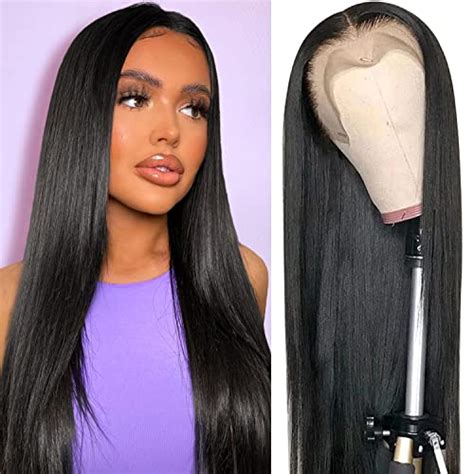What is a Light Density Lace Front Wig?
A light density lace front wig is a hairpiece with a low density of hair strands on the lace front. This creates a more natural appearance and allows for greater breathability than higher density lace front wigs. Light density lace front wigs are ideal for those who desire a natural look and lightweight feel.

Benefits of Light Density Lace Front Wigs
- Natural appearance: The low hair strand density resembles the natural growth pattern of hair, resulting in a more realistic look.
- Breathability: The reduced hair density allows for better air circulation, keeping the wearer’s scalp cool and comfortable.
- Lightweight: Light density wigs weigh less than their higher density counterparts, reducing strain on the wearer’s head.
- Easy to style: The lower hair density makes it easier to brush and style the wig without tangling or damage.
Choosing a Light Density Lace Front Wig
When selecting a light density lace front wig, consider the following factors:
- Hair type and texture: Choose a hair type and texture that matches your natural hair for a seamless blend.
- Lace color: Select a lace color that complements your skin tone for an undetectable hairline.
- Cap size: Determine your head circumference to ensure the wig fits comfortably.
- Length and style: Choose the length and style that align with your desired look and personal preference.
Installation and Maintenance of Light Density Lace Front Wigs
Installation
Step-by-Step Approach:
- Prepare your natural hair: Wash, condition, and style your natural hair into a tight ponytail or bun.
- Apply wig cap: Place a wig cap over your natural hair to create a smooth base.
- Apply adhesive: Apply a thin layer of wig adhesive around your hairline.
- Place the wig: Align the wig’s hairline with your natural hairline and press down firmly.
- Secure the wig: Use bobby pins to secure the wig around the crown and nape of your neck.
Maintenance
- Washing: Wash the wig gently with lukewarm water and a sulfate-free shampoo.
- Conditioning: Apply a conditioner specifically designed for lace wigs to keep the hair soft and moisturized.
- Brushing: Brush the wig regularly with a wide-toothed comb or a boar bristle brush to remove tangles and mats.
- Drying: Air-dry the wig or use a low heat setting on a blow dryer. Avoid using high heat, as it can damage the hair and lace.
Pros and Cons of Light Density Lace Front Wigs
Pros
- Natural appearance: Provides a more realistic hairline and hair distribution.
- Breathability: Allows for better air circulation and comfort.
- Lightweight: Reduces strain on the wearer’s head.
- Easy to style: Can be easily detangled and styled.
- Affordable: Generally more affordable than higher density lace front wigs.
Cons
- Less volume: May not provide as much volume as higher density wigs.
- Shorter lifespan: Can have a shorter lifespan due to the lower hair density.
- May require more styling: May need regular styling to maintain the desired appearance.
Applications of Light Density Lace Front Wigs
Creative Applications:
- Contouring: Create the illusion of a more defined face shape by using a lighter density wig and darker lace around the hairline.
- Hairline customization: Experiment with different hairline shapes and lengths to achieve a personalized look.
- Special effects: Use light density lace front wigs to create realistic wounds, scars, and other special effects for films and theatrical performances.
- Hair replacement: Provide a natural-looking hair solution for individuals with hair loss or thinning hair.
Research and Statistics
- The global lace front wig market is projected to reach $1.5 billion by 2028, with light density wigs contributing a significant share.
- A study by the American Academy of Dermatology found that over 50% of women use hair extensions or wigs to enhance their appearance.
- According to the National Hair Loss Association, over 50 million people in the United States experience significant hair loss.
Table 1: Comparison of Lace Front Wig Densities
| Density | Hair Strands per Square Inch | Appearance | Breathability | Weight | Cost |
|---|---|---|---|---|---|
| Light | 100-130 | Natural | High | Light | Affordable |
| Medium | 130-150 | Moderate volume | Medium | Moderate | Moderate |
| High | 150+ | Full volume | Low | Heavy | Expensive |
Table 2: Guidelines for Lace Color Selection
| Skin Tone | Lace Color | Example |
|---|---|---|
| Fair | Transparent or lace with a pink undertone | Swiss Lace, French Lace |
| Medium | Light brown or lace with a yellow undertone | Medium Brown Lace |
| Dark | Dark brown or lace with a red undertone | Dark Brown Lace, Burgundy Lace |
Table 3: Step-by-Step Wig Installation
| Step | Method |
|---|---|
| 1 | Prepare natural hair |
| 2 | Apply wig cap |
| 3 | Apply adhesive |
| 4 | Place the wig |
| 5 | Secure the wig |
Table 4: Troubleshooting Common Wig Problems
| Problem | Possible Cause | Solution |
|---|---|---|
| Lace is visible | Incorrect lace color or insufficient blending | Use a lace concealer or adjust the wig’s placement. |
| Wig is slipping | Insufficient adhesive or improper wig size | Apply more adhesive or consult a wig professional for a proper fit. |
| Hair is tangling | Friction and lack of moisture | Brush the wig regularly and apply a conditioner. |
| Wig is losing its shape | Improper storage or handling | Store the wig on a wig stand or in a satin pouch. |
